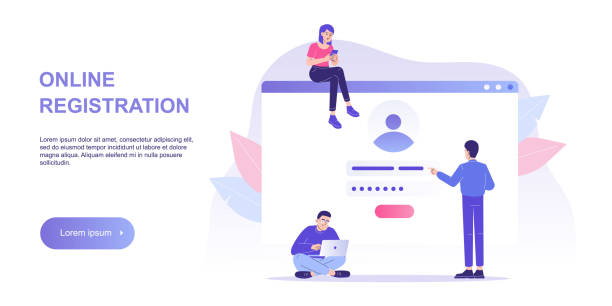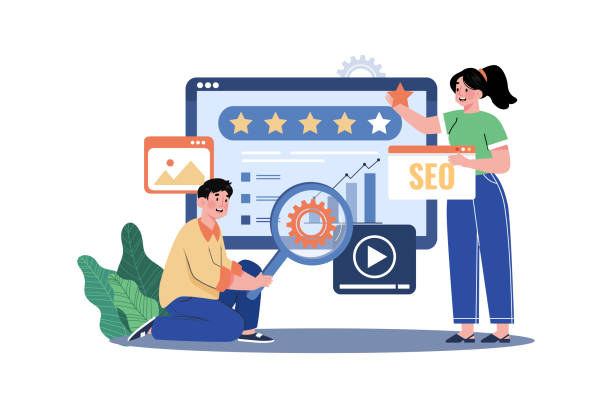1. Introduction: Why User-Friendly Website Design is Crucial?

In today’s digital world, where competition for user attention is more intense than ever, user-friendly website design is no longer a luxury option, but a vital necessity for the survival and growth of any online business.
A website with strong #user_friendly_design not only attracts users but also keeps them on the site longer and converts them into loyal customers.
The importance of this issue stems from the fact that today’s users are looking for fast, simple, and enjoyable experiences.
If your site cannot meet these expectations, users will easily move to competitor websites.
This educational approach shows us how we can provide a suitable platform for growth and development from the very beginning by understanding the needs of the audience.
The main goal of user-friendly website design is to create an intuitive User Interface (UI) and a smooth User Experience (UX) that helps visitors quickly achieve their goals, whether it’s purchasing a product, finding information, or communicating with you.
Did you know that 94% of users’ first impressions of a business are related to its website design? Transform this first impression into an opportunity for growth with professional corporate website design by **RasaWeb**.
✅ Attract more customers and increase sales
✅ Build credibility and trust in the eyes of the audience⚡ Get a free website design consultation!
2. Key Principles of Excellent User Experience and Engaging User Interface

To achieve a truly user-friendly website design, a set of fundamental principles must be considered.
These principles are the cornerstone of any successful User Experience (UX) and engaging User Interface (UI).
The first and most important principle is user-centricity; meaning every design decision should be made considering the needs, behaviors, and expectations of users.
The second principle is simplicity and clarity.
A complex or confusing design quickly frustrates users.
Information should be presented clearly and unambiguously.
User-friendly website design also requires consistency and integration; visual and interactive elements must be uniform throughout the site to convey a sense of familiarity and trust to the user.
Expertise in this field means a deep understanding of these principles and the ability to implement them in a way that not only looks good but also performs flawlessly.
3. Content Structuring and Visual Navigation: The User’s Roadmap

One of the main pillars of user-friendly website design is how content is organized and the website’s navigation system.
A strong information architecture helps the user find what they are looking for without confusion.
This section includes designing clear menus, a logical hierarchical structure for pages, and using meaningful internal links.
The navigation system should be guiding and never leave the user at a dead end.
For example, using “breadcrumbs” shows the user where they are on the site and how to return to previous pages.
Below, a table is provided as a practical guide for some critical elements in navigation design:
| Navigation Element | Description | Importance in User-Friendly Design |
|---|---|---|
| Main Menu (Header Menu) | Access to main sections of the site | The most important entry point for users to different sections, must be clear and concise. |
| Search Bar | Ability to quickly find specific content | Essential for sites with a lot of content and gives the user control. |
| Breadcrumbs | User’s current path in the site hierarchy | Facilitates navigation and prevents confusion. |
| Footer | Secondary links, contact information, social media | Provides easy access to important information and support. |
This structuring not only improves the user experience but also greatly assists in Search Engine Optimization (SEO), as search engines better index logically structured websites.
4. The Role of Visual Design and Aesthetics in User Attraction

Aesthetics and visual design play an undeniable role in user-friendly website design.
The first thing a user sees upon entering your site is its appearance.
Colors, fonts, images, white space, and the overall arrangement of elements all influence the initial feeling and visual perception of the user.
An appealing visual design not only makes the site look professional and modern but can also evoke specific emotions in the user and encourage more interaction.
For example, using calming colors on a medical site instills a sense of trust and security, while bright and energetic colors on an entertainment site create excitement and enthusiasm.
Choosing an appropriate font that is both readable and consistent with your brand identity is another important point.
User-friendly website design goes beyond mere beauty; there must be a balance between aesthetics and functionality so that the user is both visually satisfied and can easily interact with the site.
Does your current corporate website present a worthy image of your brand and attract new customers?
If not, convert this challenge into an opportunity with RasaWeb’s professional corporate website design services.
✅ Significantly improves your brand’s credibility and image.
✅ Paves the way for attracting new leads and customers.
⚡ Contact RasaWeb now for a free and specialized consultation!
5. Responsive Design and Accessibility for Everyone

In the current era, where using various devices to access the internet has become very common, responsive design (Responsive Design) has become one of the necessities of user-friendly website design.
A responsive site automatically adapts its content to the user’s screen size (whether computer, tablet, or mobile) and provides an optimal experience on any device.
This not only increases user satisfaction but is also very important for SEO, as Google prioritizes responsive websites.
In addition to responsiveness, the topic of accessibility is also of great importance.
A user-friendly website design should be usable by all individuals, including people with disabilities.
This includes providing features such as alternative text for images, keyboard navigation support, appropriate color contrast, and text enlargement capability.
This explanatory approach helps us cover a wider range of users and ensure that no one is deprived of the experience of using our website.
6. Why Load Speed and Optimized Performance Are Crucial?

One of the most important factors directly affecting user-friendly website design is site load speed.
Numerous studies have shown that users expect a website to load in less than a few seconds and quickly leave the site if there is a delay.
Even a one-second delay can lead to a significant decrease in conversion rates.
This is important news for any online business: speed equals profitability.
Optimizing images, compressing code (CSS, JavaScript, HTML), using Content Delivery Networks (CDN), and choosing a powerful host are among the actions that help improve load speed.
In addition to speed, the overall performance of the site is also important; the site should be smooth and have no delay when interacting with various elements.
This optimization not only improves the user experience but also has a direct impact on the site’s ranking in search engines and, consequently, on the amount of web traffic received.
7. Content Strategy: Creating Engaging and Targeted Content

Content is the heart of every website and plays a vital role in user-friendly website design.
Even the best visual design cannot retain users without high-quality and engaging content.
Content strategy includes planning, creating, publishing, and managing text, image, and video content that both meets user needs and advances business goals.
Your content should be specialized, informative, reliable, and at the same time entertaining.
It should answer user questions and solve their problems.
Using attractive headings, short paragraphs, bullet points, and relevant images increases content readability and makes it more pleasant for the user.
Here is a table of content types and their role in attracting and retaining users:
| Content Type | Description | Impact on User-Friendly Design |
|---|---|---|
| Blog Articles | Informative and educational content | Increases site credibility, attracts organic traffic, provides solutions to users. |
| Infographics | Visual display of complex data and information | Simplifies understanding of information, high shareability, visual appeal. |
| Videos | Tutorials, product introductions, entertainment | Increases user retention time, effective message delivery, high engagement. |
| FAQ (Frequently Asked Questions) | Answers to common user questions | Reduces need for support, increases user satisfaction by providing quick answers. |
A strong content strategy literally strengthens the foundations of a user-friendly website design and helps your site be recognized as a valuable resource.
8. Importance of User Testing and Continuous Feedback

After implementing a user-friendly website design, the work is not over.
The next crucial step is user testing and gathering feedback from real users.
No design is perfect, and there is always room for improvement.
User testing helps you identify weaknesses, navigation problems, and confusing parts of the site for users.
This process can include A/B testing, user interviews, or tracking mouse movements and clicks.
User feedback allows you to look at your site with an analytical perspective and make the necessary improvements.
This feedback and optimization cycle is an integral component of successful user-friendly website design.
Do not forget, what you, as a designer or business owner, consider user-friendly, may not be so for real users.
Are you dissatisfied with the low conversion rate of visitors to customers on your e-commerce site?
Solve this problem forever with professional e-commerce website design by RasaWeb!
✅ Increase visitor-to-customer conversion rate
✅ Create an excellent user experience and build customer trust
⚡ Get free consultation
9. Common Web Design Mistakes and Ways to Avoid Them

In the process of implementing user-friendly website design, designers may make mistakes that severely affect the user experience.
Understanding these mistakes and being aware of the guidance to avoid them is very important.
One of the most common errors is excessive complexity; adding unnecessary features and animations that only cause confusion and slow down the site.
Another mistake is neglecting mobile design, which is unjustifiable in the current era.
Questionable and irrelevant content, lack of clarity in Call-to-Action, and using unreadable fonts or inappropriate colors are also common mistakes.
To avoid these, always put yourself in the user’s shoes, prioritize simplicity, perform regular tests, and listen to feedback.
A good web design should lead the user to their destination, not lose them on a winding path.
10. Future Trends in User-Friendly Website Design and Conclusion

The world of user-friendly website design is constantly evolving, with new trends emerging as new technologies appear and user expectations change.
Artificial intelligence, Augmented Reality (AR), and Virtual Reality (VR) are opening new horizons for user experience.
Voice assistants and conversational user interfaces are also increasingly gaining importance.
We predict that in the future, user-friendly website design will move more towards personalization and predicting user needs.
Sites will become smarter and offer completely unique experiences for each user.
Ultimately, user-friendly website design is not a fleeting trend but a design philosophy based on a deep understanding of human behavior.
By focusing on these principles and keeping pace with new trends, you can build a website that is not only beautiful and efficient but also genuinely wins the hearts of users and significantly contributes to the sustainable success of your business.
This is an analysis that shows the importance of a continuous approach to optimization.
Frequently Asked Questions
And other services of RasaWeb advertising agency in the field of advertising
Smart Digital Advertising: Professional optimization to improve SEO ranking using custom programming.
Smart Data Analysis: Designed for businesses looking to increase click-through rates through custom programming.
Smart Digital Advertising: A combination of creativity and technology for customer behavior analysis by custom programming.
Smart Website Development: A dedicated service for growth in increasing click-through rates based on marketing automation.
Smart Marketing Automation: Professional optimization to attract customers using attractive user interface design.
And over hundreds of other services in the field of online advertising, advertising consulting, and organizational solutions
Online Advertising | Advertising Strategy | Sponsored Articles
Sources
- The Impact of User-Friendly Design on Business Success
- Website Design and Increasing Online Sales
- Secrets of a Successful Website Design
- The Importance of User Experience in Websites
? Is your business ready to soar to the heights of success? RasaWeb Digital Marketing Agency, by providing comprehensive and professional services, including modern and user-friendly e-commerce website design, targeted digital marketing strategies, and specialized SEO, paves the way for your brand’s growth and brilliance.
📍 Tehran, Mirdamad Street, next to Central Bank, Kazeroon Janoubi Alley, Ramin Alley No. 6
